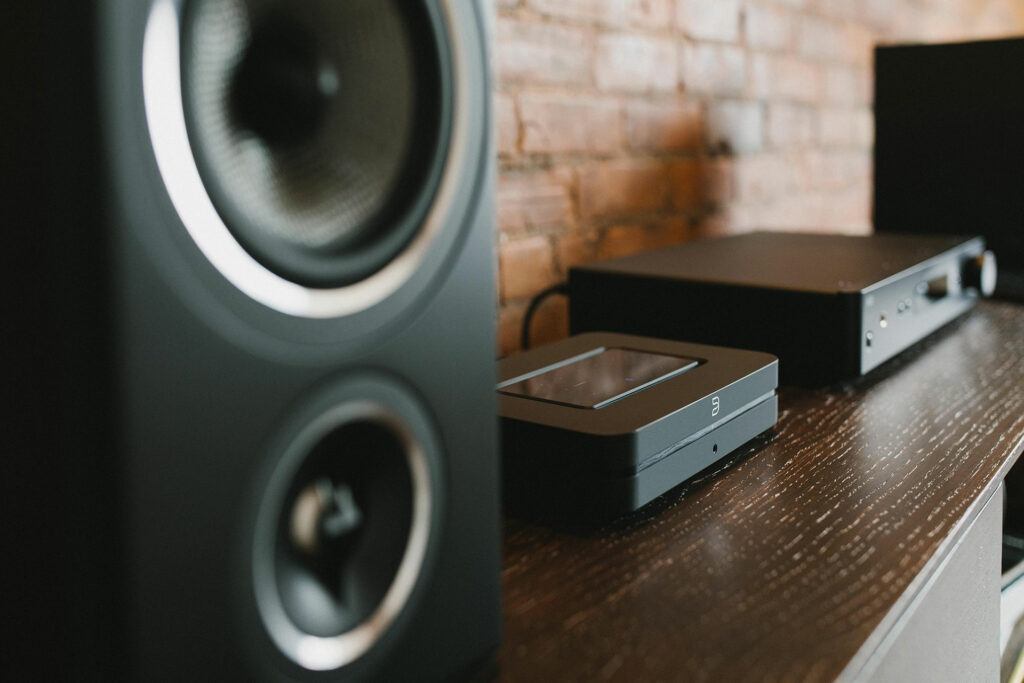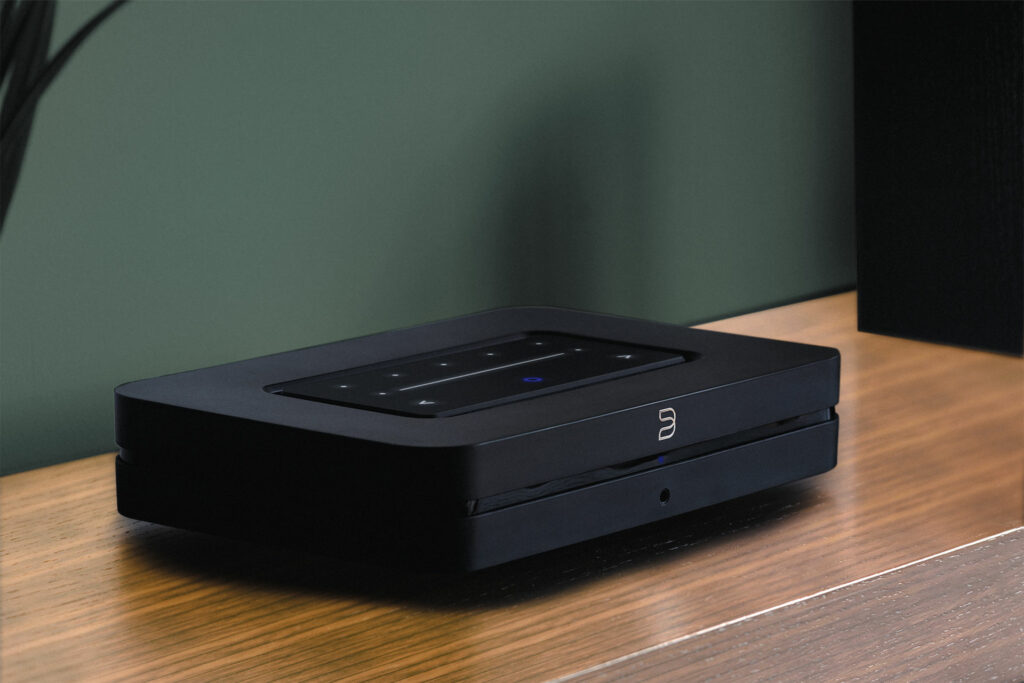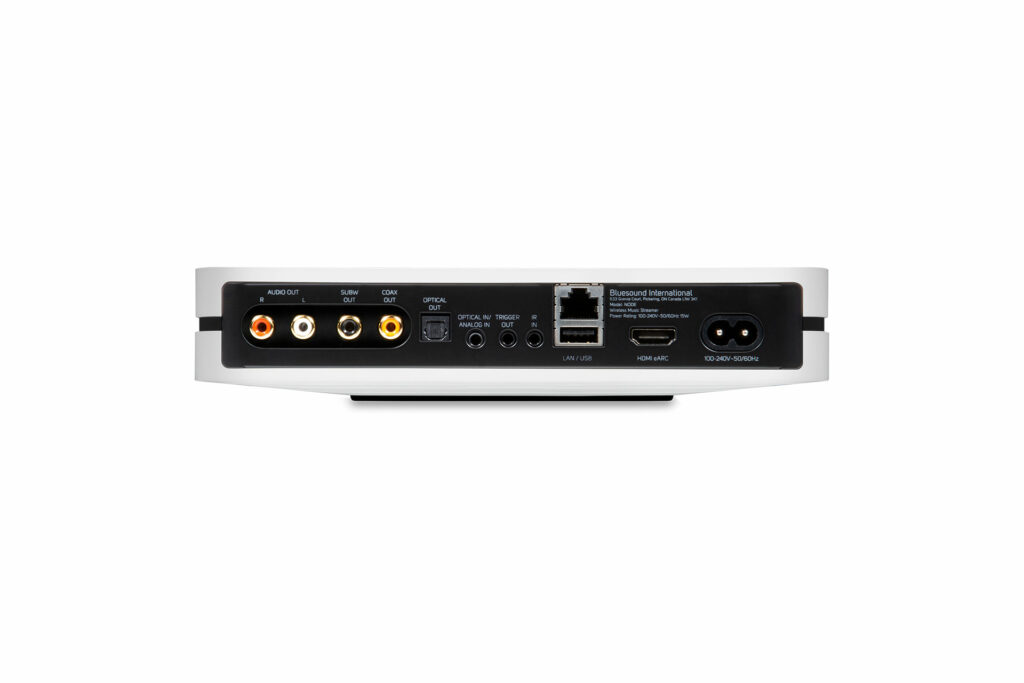The Bluesound Node music streamer (buy at Crutchfield), with its built-in DAC (digital to analog converter), provides a convenient way for consumers to access their preferred music streaming service from the Internet, or from digital music files stored on a network attached storage device (NAS), into their home audio system. Products like this combine a dedicated computer optimized for music streaming, an operating system, often but not always a control app that works from a mobile device, iPad, or computer, and lastly, a capable audiophile-grade internal DAC.
The Bluesound Node is quite popular, with over 10 years of evolution and refinement, which has earned a reputation with audio enthusiasts of being the go-to streamer on the value side of the audiophile market. It is frequently compared to much more expensive audiophile streamer/DAC combination components, since its reputation for being fully-featured, with high performance and an excellent value, is well-documented. It is important to note that competition is brutal at this price point of the audiophile or mainstream streamer market, with newer compelling entrants challenging its king of the hill position in the market. Can they do it? Let’s take a look at one of the established leaders to see what is possible.

What Makes the Bluesound Node Music Streamer So Special?
- The Bluesound Node has an ARM Cortex A53 Quad Core processor that operates at 1.8GHz at each core, combined with the proprietary operating system BluOS, which provides plenty of audio processing power. These streamers are basically mini-computers with a single purpose in mind. Years ago, such a product would have been much larger and much more expensive. Today, streamers can rule their world for a few hundred dollars, and from a small audiophile component. How things have changed …
- An audiophile-grade PCM 5242 DAC supports up to 32-bit/384 kHz digital-to-analog conversion. That’s pretty state of the art for DAC chip performance these days.
- The Bluesound Node has both a fixed and a variable audio output mode, adding preamplifier functionality if desired. There are products like the recently-reviewed Peachtree GaN 1 amp (read the review) that require a variable output from a streamer, and the Node delivers this at a very fair price.
- The BluOS operating system and controller application were recently updated to BluOS 4.0, allowing a more intuitive and convenient streaming experience, with improved navigation flow and screen views.
- The Bluesound Node has 23-plus music streaming service integrations, including Spotify, Tidal, Qobuz, (Amazon) Prime Music, Pandora, AirPlay 2-compatible and Roon Ready.
- BluOS can manage up to 64 BluOS-enabled players for wireless multi-room whole-home audio control.
- The Bluesound Node can stream and fully decode MQA (Master Quality Authenticated) files. The efficacy of MQA is controversial and is mainly available on the Tidal streaming service now (also Mugs.net, 2L Records and HD Tracks). Worth mentioning: Lenbrook, the parent company of Bluesound, acquired MQA in September of this year (2023). It will be interesting to see if Bluesound can make a case for MQA technology going forward with music-loving audiophiles.
- Bluetooth aptX HD two-way transmit and receive connectivity is supported, allowing connectivity to your mobile phone and Bluetooth headphones.
- A wired 3.5-millimeter analog output on the front of the Bluesound Node provides easy wired headphone connectivity.
- The Bluesound Node offers a wired and wireless subwoofer output with actual crossover capability, redirecting selectable bass frequencies to the subwoofer output.
- Enhanced dual-band Wi-Fi 5 802.11ac for wireless Internet connectivity, with internal antennas, contributes to the Node’s sleek casework. Additionally, the Node includes a wired Gigabit Ethernet port.
- HDMI eARC input allows the integration of a Smart Television’s streaming connectivityas an audio source to the Node for stereo audio output.
- Digital optical, coaxial, and USB audio outputs allow users to bypass the Node’s internal DAC if an external DAC is desired.
- While the Bluesound Node is mainly controlled by its app, a sensory touch panel on its top panel can control essential functions.
- The Bluesound Node is available in both matte black and white finishes.

Why Should You Care About the Bluesound Node Music Streamer?
The Bluesound Node represents a consumer-friendly uncomplicated package, yet performs fantastically at a very attractive price point. Connecting and setting up the BlueSound Node is a breeze. I downloaded the BluOS app, connected to my network, selected my streaming service, and logged in with my credentials within mere minutes. I was listening to my previously-curated playlists soon after. The extensive streaming service integration list is essential, as it ensures the stream is direct to the Bluesound Node, with the mobile device, iPad, or computer acting only as a remote control, ensuring the highest resolution and sound quality. Spotify and Tidal Connect allow native apps to connect directly to their servers through the Node. Additionally, with various digital outputs, the Bluesound Node can be connected to an outboard DAC, allowing consumers to evolve and experiment with other DACs, making the Node a high-functioning and relevant component for years.

Some Things You Might Not Like About the Bluesound Node Music Streamer…
- Streamers featuring a physical LED or OLED video screen for album cover art, which may also function as a touch screen, look amazing and can be the centerpiece of your audio system, and most often come at a premium price. The Bluesound Node is not quite as flashy, but is rather a stealthy component meant to be heard more than seen, with a smaller footprint that is more easily integrated without consuming valuable space.
- The Bluesound Node lacks balanced analog outputs in favor of the more common RCA outputs.
Listening To the Bluesound Node Music Streamer…
I connected the Bluesound Node’s analog RCA outputs to a Pass Labs XP 12 audiophile preamplifier and then to a Pass Labs XA60.8 monoblock amplifier set. Focal Kanta No. 2 floorstanding speakers completed the very revealing and high-end setup. I used Tidal for all music streaming.
As one can imagine, I listened to various recording artists and genres, old and new, which music streaming makes easy. I played Chris Stapleton’s song “You Should Probably Leave” from hisStarting Over album to see if his throaty vocals were rendered pleasantly, and the Bluesound Node did not disappoint. The crisp and clear vocals conveyed a natural texture, giving context to the song’s emotional lyrics. Sonically, the soundstage extended to the left and right of each speaker, with a lovely floating image just forward of the speakers, but not so far forward as to cause fatigue or disbelief. A robust fullness to the midrange contributed to the sensation of a live musical experience. The bass extended deep, adding to the realism and sonic impact. Lesser streamers can deliver the sound, but not all of the nuance that is on the master recording, which is why we test so many streamers and DACs in order to find the most accurate.
The audiophile classic “Aja” on the eponymous album by Steely Dan is an excellent eight-minute compilation of vocals, piano, saxophone and percussion by many stellar studio session musicians of that late 1970s era, as well as band members Donald Fagen and Walter Becker. The Bluesound Node did a great job differentiating each instrument with clarity from top to bottom, while staying musical and engaging. The image was large with depth, while projecting an image just enough to keep it interesting. On this track, Fagen proves lyrics don’t have to make sense but sound nice: vocals were yacht-rock smooth with an outstanding timbre. On this track, I did a quick comparison to one of the alternative streamers I had on hand at the time of this review, which was an Apple TV 4K, which allows me to download the Tidal app. With the volume matched, the Bluesound Node performed better with an overall more convincing image and extended frequency response best described as removing a haze layer off the soundtrack, when compared to the AppleTV 4K. I was rooting for the AppleTV 4K since I own three of them, but it was embarrassed by the Bluesound Node sonically, no matter what genre or track I tried. One last test I performed was to use the Bluesound Node as a preamplifier wired directly to the amplifiers, with the variable output turned on. Performance was solid, but not as good as going through the Pass Labs preamplifier. The audio image closed down at a lower volume, a common characteristic of digital volume control. However, overall it worked well.
Lastly, to provide some music contrast, I played the song “Driver’s License” by a newer recording artist, Olivia Rodrigo, from her debut album, Sour. The Bluesound Node revealed her compelling, heartfelt voice with warmth, which melded well with the song’s lyrics. The soundstage was wide and deep, with accurate height and a slight forward projection that kept the music interesting and without strain, a consistent characteristic of the previously-mentioned tracks. This is a worthy track to take a listen to for your next streaming session or just hear on YouTube.com.
Will the Bluesound Node Music Streamer Hold Its Value?
The Bluesound Node is a high-performing streamer DAC that punches above its price point, with features that allow you to grow your system over time, making the Bluesound Node relevant over an extended period, decreasing supply on the resale market and limiting depreciation.
There isn’t much room for the Bluesound Node to go from its low starting price, but the need for audiophiles to have multiple units in their systems is a good driver of aftermarket value. The long history of meaningful software and firmware updates also helps give the Node even more relevance over time.

Who Is the Competition for the Bluesound Node Music Streamer?
The Bluesound Node’s big brother, the $749 Bluesound Node X (buy at Crutchfield), is an obvious alternative. It is the limited-edition anniversary model of the Bluesound Node. The additional $150 adds two improvements. First is an upgraded two-channel DAC chipset from ESS model Sabre 9028Q2M, which promises to decrease clock jitter and provide a lower noise floor with higher dynamic range. Second is an improved headphone amplifier that uses THX AAA™ technology for improved performance and a more common quarter-inch headphone jack for higher-end wired headphone compatibility. All other features and functionality of the standard Node apply, and since the Bluesound Node X is still available at the time of this writing, but it is a limited edition, it likely won’t be around forever or even for the 10 years that the Node has been on the market.
I mentioned early on that competition was heating up in this product category, and the Eversolo DMP A6 at $899 (read the review) is one component bringing the fight to all manufacturers. Yes, it is three hundred dollars more than the Bluesound Node, but the impressive feature-rich specifications, its pretty six-inch touch-screen, and attractive CNC-machined aluminum casework will make you want to spend the extra bucks. The benefits of the Eversolo DMP A6 continue beyond there. With a higher-performing processor and DAC, compared to the Bluesound Node and Node X, fully-balanced XLR analog outputs, the ability to add an internal solid state drive of up to four gigabytes and preamplifier functionality, the Eversolo DMP A6 creates an economical path to a high performance front end of a sophisticated audio system. Like Bluesound, Eversolo has its proprietary operating system and control app with plenty of built-in music services. The Eversolo operating system (EOS) audio engine has an advantage with its ability to bypass the Android SRC restriction, allowing direct audio output of third-party apps like Apple Music, which is typically only available for streaming through Airplay 2. The drawback to the Eversolo DMP A6 is its recent arrival, since it is a newcomer to the audio scene and does not have the 10-year head start of Bluesound and its ecosystem. However, the DMP A6 is one hell of an opening for Eversolo’s first act.
Cambridge Audio NX10 at $599 is more in line with the Bluesound Node’s price point, with similar processing power, feature set, and an established reputation of producing streamers for over 10 years. Like Bluesound and Eversolo, Cambridge Audio created its own operating system and control app – StreamMagic. It operates in the same capacity as BluOS and Eversolo, processing audio and cataloging your music preferences with the control app from a mobile device or iPad. Bluesound has more streaming services integrated into its operating system, but Cambridge Audio covers all the prominent services. If you prefer the look of a larger component, perhaps the Cambridge NX10 is an alternative.

Final Thoughts on the Bluesound Node Music Streamer
The Bluesound Node (buy at Crutchfield) is an impressive streamer DAC, with actual high-end performance beyond its $499 price tag. Additionally, it is worth emphasizing that computer devices, like streamers, can be glitchy. With my extended audition of the Bluesound Node, I experienced consistent, reliable, and bug-free performance. It was easy to set up and get online, and the system was rock-solid over extended use. Lastly, if you are building an audio system on a tight budget, the Bluesound Node could be a great starting point: begin with the Bluesound Node in variable output mode and its preamplifier functionality to drive a separate amplifier(s) and speakers and even a subwoofer of your choice.
Regardless of its implementation, the Bluesound Node still remains a solid consideration and a low-risk, no-regret way to start or grow your audio journey.




Reviewers seem never to mention it, but BluSound OS does not play DSD natively, even though the BluSound hardware’s ESS chips should allow that. Instead, it converts DSD files to FLAC. It isn’t a big deal to most audiophiles, but for the minority who are invested in DSD files, other options may be better. At least, purchasers should know the limitation before buying.